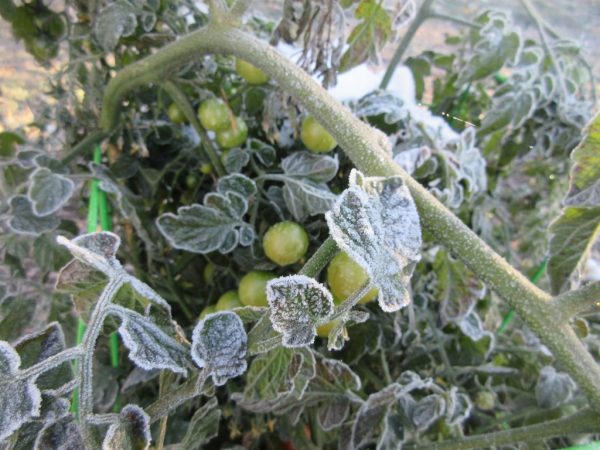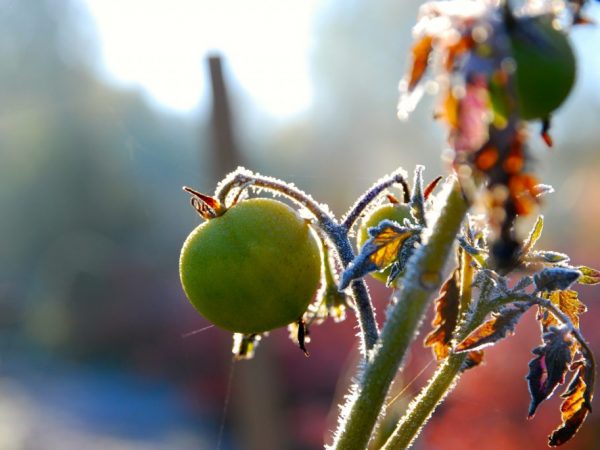Actions if tomato seedlings are frozen
Some gardeners give up if tomato seedlings are frozen. However, there are a number of useful tips on what to do if greenhouse tomatoes are frozen and how to save frozen seedlings in an open garden.

Ways to save frozen seedlings
Biostimulant treatment
If the tomatoes are frozen in a greenhouse or in the open field, they try to spray them as quickly as possible with a special biostimulant called Epin. This domestic drug strengthens the immune system of tomato culture, it has established itself as an effective adaptogen if you want to save tomato seedlings when they are frozen at a negative temperature.
Terms of use
Spraying of seedlings with Epin is carried out mainly in the morning hours or at the onset of late evening. Experienced gardeners do not recommend spraying tomato bushes with this drug in the daytime, since the active component epibrassinolide, which is part of it, will quickly evaporate when exposed to daylight.
Seedlings are sprayed with Epin when the tomatoes are frozen, taking into account the processing features:
- all parts of the tomato bush are processed, including foliage, stem and branches,
- it is necessary to spray the foliage from both sides, including the bottom,
- the frequency of processing is once every 7-10 days until the green bushes of tomatoes are completely restored.
When preparing a working solution with Epin, an alkaline medium of plain water, which reduces the effectiveness of its active component, requires adding a pinch of citric acid to the liquid and only then diluting the drug with it. The proportion for the working solution will be one 5 liter bottle.
The assimilation of Epin by the plant occurs after 2-3 days, therefore, the treatment with the agent is required in calm weather and in the absence of precipitation.
Water irrigation
If the tomatoes are frozen in a closed greenhouse or on a glassed-in balcony, when the frost has not dropped below the minus temperature of -2-3 ° C, you can revive the frozen seedlings by pouring over the tomato bushes. This procedure allows you to return the moisture lost by the plant and stimulate sap flow along the stem.
In frosts with a temperature of -2-3 ° C, when the stems of a tomato plant are covered with an ice crust, there is no benefit from resuscitation procedures.
Several buckets of chilled water are prepared for pouring. Watering tomato bushes is required so that water remains on the foliage, stem and branches. Seedlings planted in open, unprotected soil are watered before sunrise.
Pruning frozen tops

Frozen plant tops should be cut off
If the tomato seedlings freeze strongly, the aerial top of the plant will not recover, however, the root system of such a tomato bush most often remains alive and is not damaged by frost.In this situation, when choosing a method of how to save frozen tomato seedlings, they often turn to cutting the aerial part right down to the soil surface. With a radical restoration of frozen seedlings by cutting, the top is cut off with a sharp garden tool.
If a tomato bush that grows not in a greenhouse, but on unprotected soil is frozen, after cutting off the damaged parts, a small greenhouse is installed above the plant.
After pruning the top of the bush, it is imperative to carry out bait. This is done using urea, which is abundantly watered with the underground parts of the plant remaining after cutting. From above the tomato bushes are covered with foil. As a rule, fresh stepchildren can germinate after a few days and, with proper further care, give a good harvest, but a couple of weeks later than usual.
Secondary landing
The ability of a tomato crop to effectively propagate by a vegetative method plays a positive role in saving frozen tomato seedlings, in which part of the root system has died. The dead plant roots are cut off, placed in water and, when new roots appear, the seedlings are planted again in a greenhouse or open soil.
It is possible to reanimate severely damaged tomato seedlings using this method only as long as the non-frozen root length allows it and provided that the initial planting of the plant was carried out in a deliberate manner.
Shadow creation
When the tomatoes are frozen in the greenhouse, slightly frozen tomato seedlings can be saved by hiding them from direct sunlight until the bushes move away. This is done with the aim of thawing them under natural conditions without exposure to harmful sunlight. This method of creating a shadow is used only when the greenhouse seedlings of tomatoes are frozen, but have not yet had time to ice and turn black.
A simple cardboard or a temporary greenhouse can create a shade for seedlings on open soil. The use of a biostimulant will be an additional stimulus for the restoration of seedlings.
The thawed moisture will remain on the villi of the stem and leaves of the tomato bush, will not dry out quickly in the absence of direct sunlight and will allow the plant to acquire its original appearance in a day. For tomato seedlings planted in unprotected soil, it is important to create protection against the sun before it rises.


